INVERSE FUNCTIONS USING TABLES
Subscribe to our ▶️ YouTube channel 🔴 for the latest videos, updates, and tips.
Example 1 :
Suppose f is the function whose domain is the four numbers {√2, 8, 17, 18}, with the values of f given in the table shown here in the margin.
(a) What is the range of f ?
(b) Explain why f is a one-to-one function.
(c) What is the table for the function f −1?
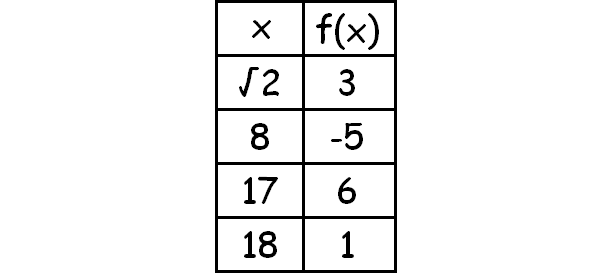
Solution :
(a) In the table above, x represents domain and f(x) represents range. Hence the range of the function is
{3, -5, 6, 1}
(b) From the table above, it is clear that every element of x is associated with an unique element of f(x). Hence it is one to one function.
(c) From the table above,
f(√2) = 3, f(8) = -5, f(17) = 6, f(18) = 1
f-1(3) = √2, f-1(-5) = 8, f-1(6) = 17, f-1(1) = 18
The table for the function f-1 :
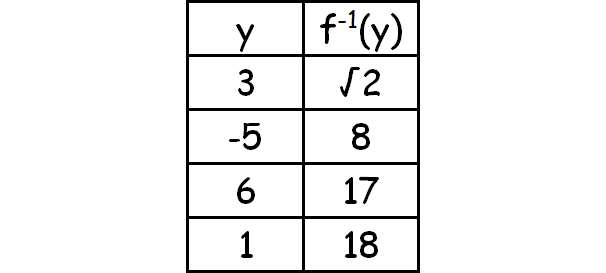
Example 2 :
For f and g are functions, each of whose domain consists of four numbers, with f and g defined by the tables below:
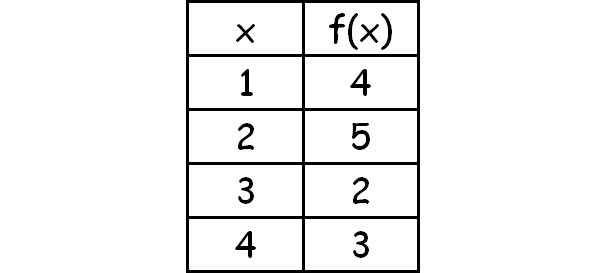
(a) What is the domain of f ?
(b) What is the range of f ?
(c) Sketch the graph of f.
(d) Give the table of values for f−1.
(e) What is the domain of f−1?
(f) What is the range of f−1?
(g) Sketch the graph of f-1.
(h) Give the table of values for f−1 o f.
(i) Give the table of values for f o f-1.
Solution :
(a) Domain of f = {1, 2, 3, 4}
(b) Range of f = {2, 3, 4, 5}
(c) The graph of f consists of all points of the form
(x, f(x))
as x varies over the domain of f . Thus the graph of f, shown below, consists of the four points :
(1, 4), (2, 5), (3, 2), (4, 3)
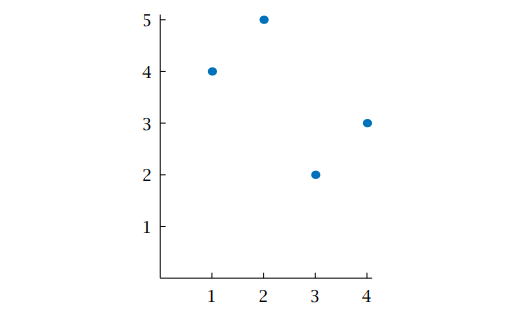
(d) The table for the inverse of a function is obtained by interchanging the two columns of the table for the function (after which one can, if desired, reorder the rows, as has been done below) :
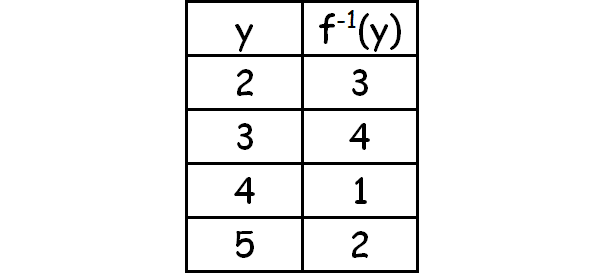
(e) Domain of f-1 = {2, 3, 4, 5}
(f) Range of f-1 = {1, 2, 3, 4}
(g) The graph of f-1 consists of all points of the form
(x, f-1(x))
as x varies over the domain of f-1. Thus the graph of f-1, shown below, consists of the four points :
(4, 1), (5, 2), (2, 3), (3, 4)
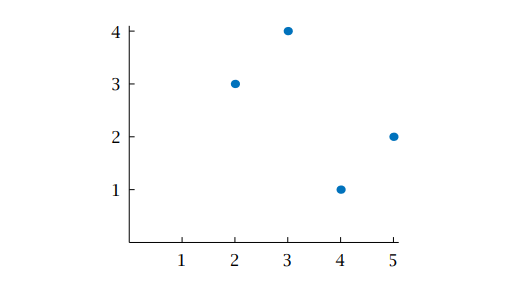
(h)Table of values for f-1 o f :
(f −1o f) (1) = f−1[f(1)] = f−1(4) = 1
(f −1o f) (2) = f−1[f(2)] = f−1(5) = 2
(f −1o f) (3) = f−1[f(3)] = f−1(2) = 3
(f −1o f) (4) = f−1[f(4)] = f−1(3) = 4
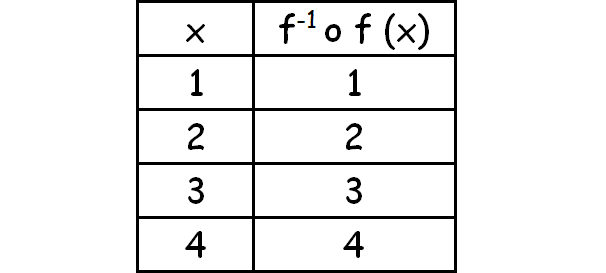
(i) Table of values for f o f-1 :
(f o f −1) (2) = f[(f−1(2)] = f(3) = 2
(f o f −1) (3) = f[f−1(3)] = f(4) = 3
(f o f−1) (4) = f[f −1(4)] = f(1) = 4
(f o f −1) (5) = f[f−1(5)] = f(2) = 5
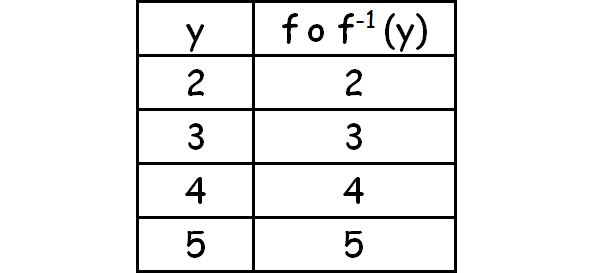
Example 3 :
The following table gives values of a function f(x) for six inputs 0, 1, 2, 3, 4, and 5.
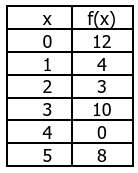
Read the table to find:
|
a. f(4) = b. f(2) = c. f(0) = d. f(5) = |
e. f –1 (10) = f. f–1(3) = g. f –1(0) = h. f –1(12) = |
Solution :
|
a. f(4) = 0 b. f(2) = 3 c. f(0) = 12 d. f(5) = 8 |
e. f –1 (10) = 3 f. f–1(3) = 2 g. f –1(0) = 4 h. f –1(12) = 0 |
Example 4 :
If f(x) = (1/8)x - 3, g(x) = x3, h(x) = 2x + 1
Find (f∘g)-1 (5) ?
Solution :
To evaluate (f∘g)-1 (x), first let us find (f∘g) (x) and then find its inverse.
(f∘g) (x) = f[g(x)]
= f[x3]
f[g(x)] = (1/8)x3 - 3
Finding inverse of (f∘g) (x) :
Let y = (1/8)x3 - 3
y + 3 = (1/8)x3
x3 = 8(y + 3)
x3 = 8y + 24
x = (8y + 24)1/3
(f∘g)-1 (x) = (8x + 24)1/3
(f∘g)-1 (5) = (8(5) + 24)1/3
= (40 + 24)1/3
= (64)1/3
= 4
Example 5 :
Find a table of values for each function and its inverse.
f(x) = 3x + 1
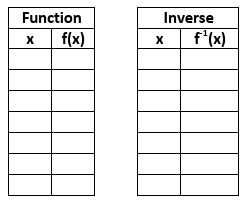
Solution :
f(x) = 3x + 1
|
When x = -4 f(-4) = 3(-4) + 1 f(-4) = -11 |
When x = -3 f(-3) = 3(-3) + 1 f(-3) = -8 |
When x = -2 f(-2) = 3(-2) + 1 f(-2) = -5 |
|
When x = -1 f(-1) = 3(-1) + 1 f(-1) = -2 |
When x = 0 f(0) = 3(0) + 1 f(0) = 1 |
When x = 1 f(1) = 3(1) + 1 f(1) = 4 |
When x = 2
f(2) = 3(2) + 1
f(2) = 7
Writing these values as ordered pairs for the function f(x) :
(-4, -11) (-3, -8) (-2, -5) (-1, -2) (0, 1) (1, 4) and (2, 7)
Ordered pairs for the function f-1(x) :
(-11, -4) (-8, -3) (-5, -2) (-2, -1) (1, 0) (4, 1) and (7, 2)
Example 6 :
Let n = f(t) = 0.25 t – 1.67 represent the number of people (in millions) undergoing laser eye surgery in the year that is t years since 1990.
a) Find & interpret f(10).
b) Find an equation for f –1.
c) Find & interpret f –1(3).
d) What is the slope of f –1?
What does it mean in the context of this problem ?
Solution :
a) f(t) = 0.25 t – 1.67
f(10) = 0.25 (10) – 1.67
= 2.5 - 1.67
= 0.83
In the year 2000, 83 million people were undergoing laser eye surgery
b) Finding inverse :
f(t) = 0.25 t – 1.67
Let y = 0.25 t – 1.67
y + 1.67 = 0.25t
(y + 1.67)/0.25 = t
f –1(x) = (x + 1.67)/0.25
Find an equation for f –1.
c) f –1(3) = (3 + 1.67)/0.25
= 4.67/0.25
= 18.68
Approximately 19 years
After 19 years in the year of 2009 3 million people were undergoing the laser eye surgery.
d) slope of f –1 is 4.
Subscribe to our ▶️ YouTube channel 🔴 for the latest videos, updates, and tips.
Kindly mail your feedback to v4formath@gmail.com
We always appreciate your feedback.
About Us | Contact Us | Privacy Policy
©All rights reserved. onlinemath4all.com

Recent Articles
-
10 Hard SAT Math Questions (Part - 44)
Jan 12, 26 06:35 AM
10 Hard SAT Math Questions (Part - 44) -
US Common Core K-12 Curricum Algebra Solving Simple Equations
Jan 07, 26 01:53 PM
US Common Core K-12 Curricum Algebra Solving Simple Equations -
10 Hard SAT Math Questions (Part - 4)
Jan 05, 26 06:56 PM
10 Hard SAT Math Questions (Part - 4)
